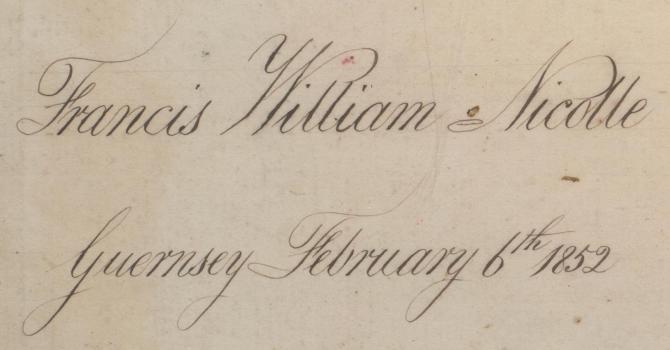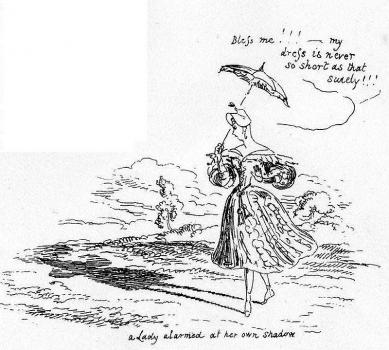27th July 2015
The 1850s gold rush in Australia attracted thousand of immigrants and would-be prospectors, and Guernsey was by no means immune to gold fever. 18-year old William Francis Nicolle recorded his voyage to Melbourne in the summer of 1852 in his Journal, which was generously donated to the Library by Stephen Foote. Nicolle followed this with an account of his return from Australia in the freezing cold on board the Avon. His Journal also includes a substantial amount of family history material (Nicolle, De Garis, Lainé, Lamble &c.), as well as other accounts of later voyages made on board cargo ships. He was a carpenter by trade, and the book also includes carefully written instructions for calculations, presumably for reference purposes. Finally, his poem in memory of Nicholas de Mouilpied, who died on the voyage out, aged 22.
8th May 2015
The trouble with Napier. From the Morning Post, June 19 1844.
From the Library's militia collection. A transcript by Edith Carey of a letter in French from a worried Lieutenant-Bailiff, Eléazar Le Marchant, to the absent Lieut.-Governor, Sir Edmund Andros, (here translated), and a contemporary copy of a petition concerning the same mutiny from William De Lisle in the St Peter's militia, to the Privy Council. Complicated family ties and nepotism, and a reflection of the bitter factional resentment felt towards Edmund Andros.
From the Star, June 7 1900. Sent from Wynburg, Orange Free State, and dated May 5, 1900. The author of this and other letters was Roland W. Mourant, of the City Imperial Volunteers (C.I.V.). He was son of James Mourant, of Gloucester House, High Street, a funeral director.
Two letters by merchant and functionary Havilland Le Mesurier, one to his wife Elizabeth Dobree and the other to daughter Harriet Le Mesurier, from nearly 200 written while he was away working for the Army's Commissariat, in the Library collection.
From the Mann-Dobrée letters, in the Library.
[The Star]: The following letter, dated September 23rd, 1833, written by a young man who left this island for the United States in the spring of the year, has been handed to us for insertion by one of his friends who recently received it. We give it insertion without of course pledging our faith to the correctness of the statements which it contains:
A letter from the Star, October 31, 1836, describing a skirmish at Emetza. The Adjutant-General of this Legion at this time was Gaspard Le Marchant, son of Major General John Gaspard Le Marchant, and it is presumably he who had his horse killed under him, as the letter describes. The Priaulx Library recently acquired an Order Book of this regiment which covers the period during which the Legion was at San Sebastian, a town on the north coast of Spain; Le Marchant signs all the orders. The Anglo-Spanish Legion was a voluntary force put together by the British army at the request of the Spanish to help them in a civil war which arose because of a contested succession to the Spanish throne. The Orders in our book are dated 4 Jun 1836, until 30 March 1837 and are all issued from San Sebastian.
Vive la Flounce! A comic piece in the form of a letter to the Editor of the Star newspaper of July 24, 1834, on the islands' peculiar custom of 'flouncing,' or affiancing, by a visiting wit who called himself 'Time-killer;' and a description of flouncing in Alderney, from Captain Wood's Subaltern Officer, published in 1825. The pictures are from Cruickshank's Sketchbook of 1834-6, part of the Priaulx Library's extensive collection of work by this illustrator.
A translation of part of Laurent Carey's manuscript On the Customary Law of Guernsey, from the Guernsey and Jersey Magazine, Vol. V, 1838, edited by F. B. Tupper. Carey's Essai, written around the 1750s, formed the day-to-day reference for the proceedings of the Royal Court, under whose auspices it was eventually published in 1889. Here he was illustrating the fact that the inhabitants of Guernsey can choose to accept the proposed sovereign or not, who, once accepted, becomes 'un prince de leur propre choix'—and display absolute loyalty when they do so. The photograph below shows the proclamation of George V in Guernsey in 1910. The letter above is an invitation from the Governor to the constables to attend the proclamation of 1714. Library collection.



